The Val d’Orcia region in Tuscany is a true gem for any traveler looking for breathtaking landscapes.
Known for its picturesque views, it is a favorite spot for photographers from all over the world.
In recent years, the area has also become a popular place for people of all backgrounds to call home, drawn in by the natural beauty of the region.
The Val d’Orcia is located southeast of Siena and is named after the Orcia River that runs through it.
The region is bordered by the towns of Montalcino and Montepulciano and reaches the border of Umbria.
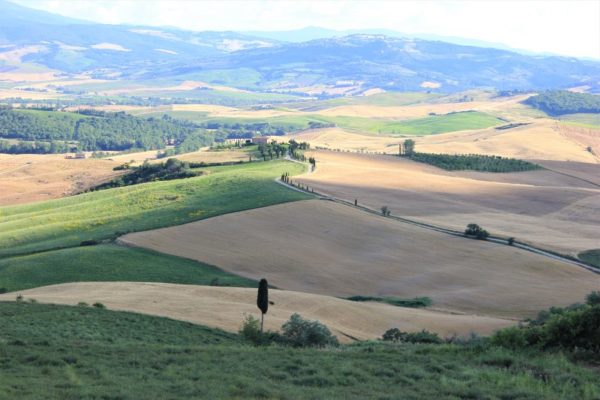
Panorama from the Pieve of Corsignano
A holiday in the Val d’Orcia region is perfect for those who appreciate sustainable tourism that preserves and enhances the local culture, history, and natural beauty.
Visitors can indulge in the region’s rich history and art, while savoring the delicious local food and wine.
But that’s not all, the Val d’Orcia also offers a wide range of outdoor activities such as horseback riding, hiking, and both road and mountain biking.
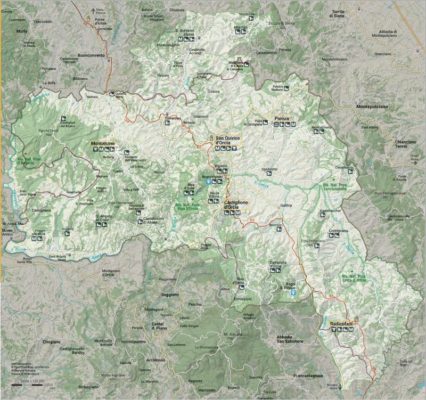
Val d’Orcia map (© visittuscany)
If you’re planning a trip to the Val d’Orcia and only have two days, we’ve put together a rough itinerary to help you make the most of your time.
Additionally, if you have a few more days to spare, we recommend visiting the towns of San Quirico d’Orcia, Bagno Vignoni, the Fortress of Radicofani, and the Rocca a Tentennano.
Table of Contents
- Guided Tour from Siena
- Where to Stay in Val d’Orcia
- What to see in Val d’Orcia in two days
- Chapel of Our Lady of Vitaleta
- Montepulciano
- Pienza
- Photo Tour #1
- Abbey of Monte Oliveto Maggiore
- Montalcino
- Photo Tour #2
- Abbey of Sant’Antimo
Guided tour from Siena
If you don’t have access to a vehicle, there are several tours available that depart from Siena and take you to some of the most fascinating destinations in the Val d’Orcia region.
One tour that we recommend is a nine-hour excursion to Montalcino, Pienza and Montepulciano.
This tour offers a comprehensive experience that includes history, art, beautiful landscapes, and local products such as wines and traditional foods.
The tour is guided in English, and during the day, you’ll have the opportunity to visit two renowned wineries.
Taste some of the world’s most famous wines like Brunello di Montalcino and Vino Nobile di Montepulciano and enjoy some delicious local delicacies like cheeses, sausages, and extra virgin olive oil.
This tour is a great way to experience the best of the Val d’Orcia region without the need for a car.

Farm near the Chapel of Our Lady of Vitaleta
Another tour option for wine lovers is a five and a half hour wine tour of Montalcino.
This tour is also guided in Italian and allows you to take in the beautiful landscapes of the Val d’Orcia region during the minibus ride.
The highlight of the tour is a visit to a winery where you can taste the renowned Brunello, commonly referred to as the “red gold of Montalcino.”
Before the tasting, you’ll learn about the history of the wine, the production process, and the sensory characteristics of the Sangiovese grape used to make it.
The tasting is paired with platters of typical Tuscan cold cuts.
You’ll also have some free time to explore the historic village of Montalcino on your own.
Where to stay in Val d’Orcia
In addition to exploring the Val d’Orcia, the itinerary for our Tuscany trip also included a few days to discover the highlights of the Maremma region.
We researched different options for accommodation and considered two possibilities.
The first option was to find a single accommodation that was centrally located and equidistant from all the places we wanted to visit.
The second option was to find two accommodations, one for our stay in Maremma and another for our stay in the province of Siena.
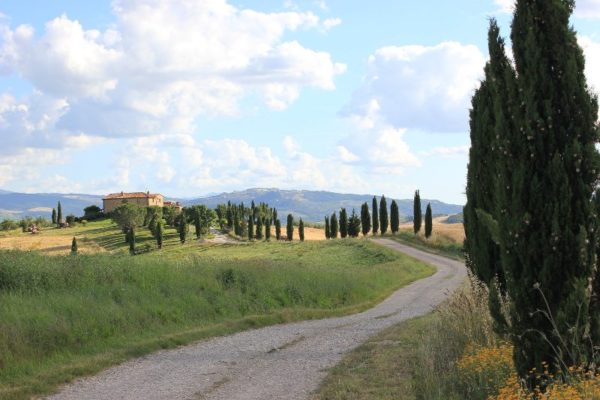
Terrapille farmhouse near Pienza
While this second option would have allowed us to stay closer to the places we wanted to visit and reduce our travel time, it would have also meant that we would have had to plan our visit to Siena and its surroundings for the last days of our trip.
But we preferred to have a more flexible itinerary and the desire to visit the island of Giglio and the Val d’Orcia on sunny days.
Ultimately, we decided on the first option and established our residence in a hotel located in Roselle, a village on the outskirts of Grosseto.
This allowed us to have a base to explore the Maremma and the Val d’Orcia.
In any case we can assure you that Val d’Orcia region offers a huge variety of accommodation options for visitors.
For those who want to fully immerse themselves in nature, there are options such as farmhouses and family-run bed and breakfasts that offer a true paradise-like experience.
These options are perfect for travelers who want to get away from the hustle and bustle of everyday life and relax in peaceful surroundings.
If you’re looking for a place to stay in the Val d’Orcia, you can check out the best offers and book your accommodation through the following link.
It can be a good idea to book in advance as these types of accommodations tend to fill up quickly, especially during peak season.
Here you can check the offers and availability of
What to see in Val d’Orcia in two days
It had been many years since our last visit to Tuscany, and as we looked through the beautiful photos of the Val d’Orcia and the Maremma on social media, we knew we had to return.
Traveling often means we visit far-off places and overlook the beauty right in our own backyard.
Our wanderlust led us back to Tuscany, and we were excited to finally see the Val d’Orcia and the Maremma in person.
If you’re planning a trip to the Val d’Orcia and only have two days, we’ve put together a rough itinerary to help you make the most of your time.
We’ll take you to charming towns with well-preserved Renaissance architecture, taste local wines and cheese, and enjoy the beautiful landscapes of this region.
But this is just a rough guide, and you can adapt it to your own preferences and interests.

The alleys of the historic center of Montalcino
Day #1
After having breakfast on the terrace of our residence, we set out on our journey north-east.
As we pass through the village of Paganico, the road begins to wind its way uphill through olive groves, vineyards, and broom bushes.
We pass by numerous farms specializing in wine production, a clear indication of the thriving wine industry in the area.
The valley is a UNESCO World Heritage site and extends to the foothills of Monte Amiata.
It is a picturesque landscape of fields of wheat waiting to be harvested, hay crops ready for shearing, shrubs and wildflowers.
Narrow streets lined with cypress trees lead to small villages perched on the hilltops.
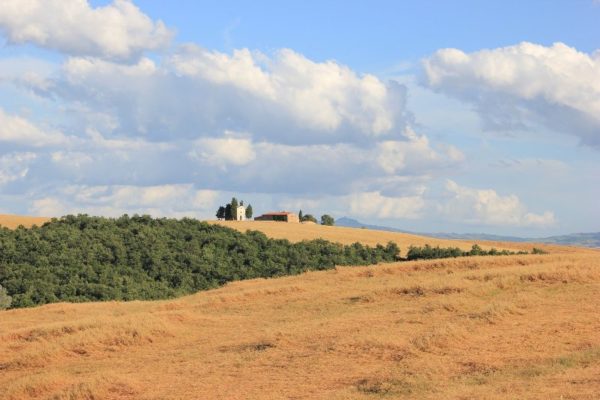
The Chapel of Our Lady of Vitaleta spotted from the main road
Chapel of Our Lady of Vitaleta
From the road that leads from San Quirico d’Orcia to Pienza, we decide to take a detour.
Thanks to a dirt road, we reach one of the most photographed places in the entire valley, the Chapel of Our Lady of Vitaleta.
The church, probably dating back to 1500, was redesigned by the architect Giuseppe Partini in the 1800s, drawing inspiration from 16th-century models.
As we arrive, we find ourselves alone in the serene surroundings, with no sign of human presence nearby.
We take our time exploring the chapel, each of us absorbed in our thoughts, almost afraid to break the spell by disturbing the peacefulness.
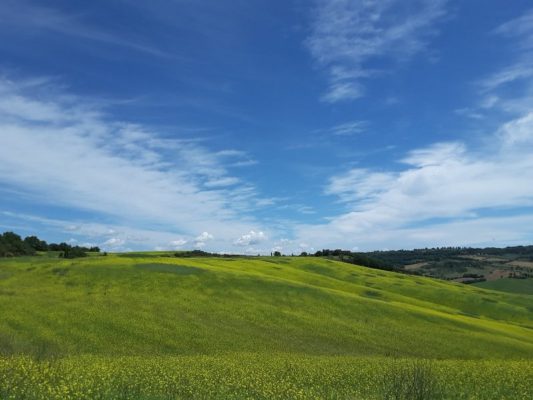
Landscape from the dirt road that leads to the Madonna of Vitaleta Chapel
Montepulciano
We continue our journey and head to Montepulciano, which is located just outside the borders of the Val d’Orcia.
We park our car outside the walls and enter the village through Porta al Prato.
We walk along the Corso, a winding, sloping road about a kilometer and a half long that divides the town in two.
As we walk, we pass by historic buildings, artisan shops, and commercial establishments.
In front of the Church of Sant’Agostino stands the Clock Tower of Pulcinella.
It is a medieval tower with the silhouette of the famous Neapolitan mask on top, marking the hours.
After visiting the Cantina Contucci, the natural end to our walk is Piazza Grande, from which we overlook the Town Hall, Cathedral and the well of the Griffins and Lions.
The square is elegant and refined.
Sitting on the steps adjacent to the basilica, we see two American boys entertaining passers-by with flute and guitar.
The acoustics are perfect, we take a seat on a stone bench sheltered from the sun and enjoy their musical performance.
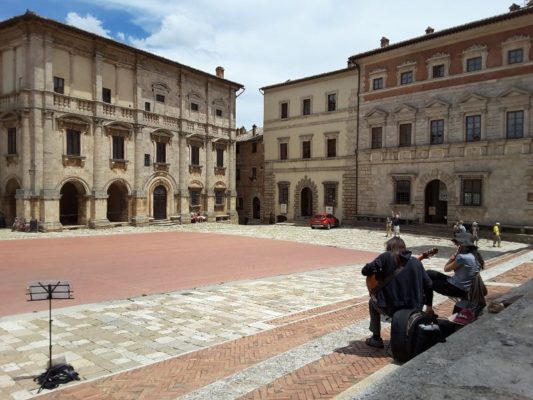
Piazza Grande in Montepulciano
Before leaving the town, we stop by a tavern for a glass of Vino Nobile.
It’s one of the oldest wines in Italy, with a ruby color, made from a selection of the Sangiovese grape called prugnolo gentile.
It’s aged for at least two years, starting from January 1st following the harvest.
We savor a glass of 2012 vintage of Vino Nobile, which has been rated as excellent by sommeliers, and enjoy it with a selection of cheeses and sausages like wild boar salami and finocchiona offered by the tavern.
Montepulciano also offers guided tours with tastings that include visits to two famous wineries in the historic center.
The tour lasts about two and a half hours and the guide speaks English.
By the end of the tour, you will be a lover of Vino Nobile.
You can check the tour details and book it here:
On our way back to Pienza, we stop at a farm that produces typical cheeses of the area.
From the flock of sheep grazing on the ridge of the hill adjacent to the cottage, it’s clear where the milk for production comes from.
The farm’s shop has stacked forms of pecorino and marzolino in different variations like fresh, tomato, reserve, chilli, truffle and even must.
The marzolino is so called because it is produced with milk milked in early spring, when the pastures rich in thyme, santoreggia and artemisia offer the most tender and fragrant grass.
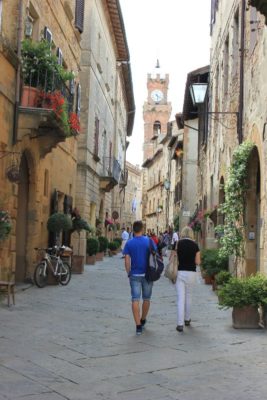
A walk through the alleys of Pienza
Pienza
In the early afternoon we visit Pienza, known as the ideal city of the Renaissance.
The village, located on top of a hill, was curated by Bernardo Rossellino and since 1996 is a UNESCO World Heritage Site.
The history of ancient Corsignano had a turning point in 1459, when Enea Silvio Piccolomini ascended to the papal throne with the name of Pope Pius II and decided to settle in his native country.
For some years Pienza, named in his honor, became a thriving artistic, architectural and cultural laboratory.
We access the village through Porta al Murello, where we find the small but efficient Tourist Office, a great place to gather all the necessary information on what to see in Pienza.
As we walk through the narrow streets, we’re overlooked by numerous shops.
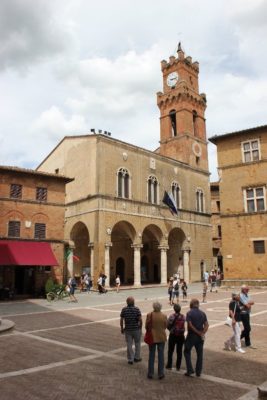
Piazza Pio II in Pienza
Next to the entrance doors of Pienza, a wicker basket containing beautiful surfinie is hung on the wall.
The epicenter of the town is certainly Piazza Pio II, where we find the Duomo and Palazzo Piccolomini.
The latter was built in stone worked in ashlar and expresses its elegance already from the entrance courtyard.
Once we have picked up our audio guides, we begin the tour that lasts about forty-five minutes and leads us into finely furnished rooms.
The route ends at the back of the building with a visit to the roof garden, where we can admire wonderful views of the valley behind.
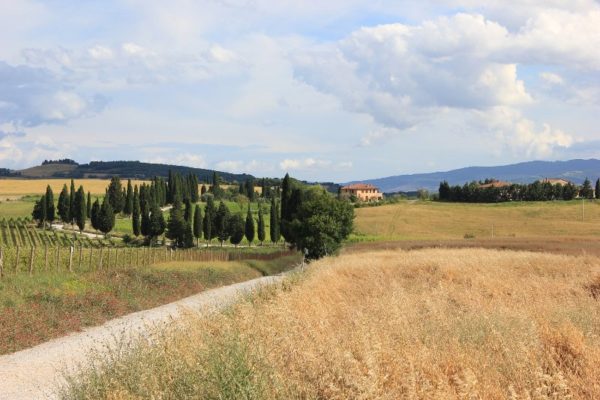
Landscape between Pienza and Montichiello
Photo Tour #1
As the sun sets and the light changes, we embark on a photo tour, a loop around Pienza.
The tour takes us through paved and dirt roads in the village of Monticchiello, then on the undulating path bordered with cypress trees that connects the Pieve di Corsignano to the Terrapille farmhouse.
The end of the tour is a few hundred meters outside Pienza in one of the most illustrated places on posters and postcards, known as Cipressini.
The day is now coming to an end and we thank the Val d’Orcia for having delighted us with its beauties.
In our opinion, the visit should be lived on the road, with curiosity and a spirit of freedom, following one’s instinct.
Take time to explore the natural viewpoints located along the road, relieve yourself from the main arteries and lose yourself in country lanes beaten only by tractors and tracked vehicles.
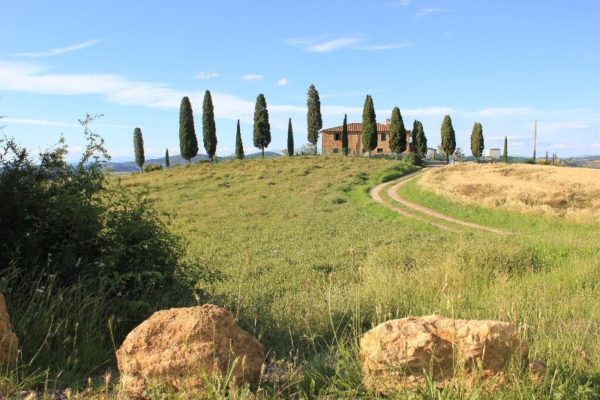
The Cypresses of Pienza
Day #2
Despite initial weather forecasts predicting rain and thunderstorms for today, we decide to take a chance and continue with our planned visit of the Val d’Orcia.
Abbey of Monte Oliveto Maggiore
Our day begins with a visit to the Crete Senesi area, specifically the Abbey of Monte Oliveto Maggiore.
We park our car at the end of the road leading to the abbey, located outside the village of Buonconvento.
The monastic complex was founded in the 14th century by Bernardo Tolomei and is still home to a small community of Benedictine monks.
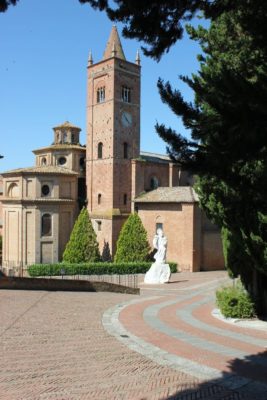
Abbey of Monte Oliveto Maggiore
The highlight of the visit is the Great Cloister, adorned with beautiful frescoes depicting scenes from the life of St. Benedict.
During our visit, we have the opportunity to witness a traditional Catholic mass led by the resident monks, singing Gregorian chants.
After touring the cloister and various rooms within the abbey, we leave feeling inspired and rejuvenated by the serene ambiance of the ancient monastery.
Montalcino
As we make our way to Montalcino, the first drops of rain begin to fall, but it’s not enough to discourage us from continuing our walk along the village’s high walls.
Montalcino, founded in the 10th century, is located on top of a hill and has a rich history of military importance.
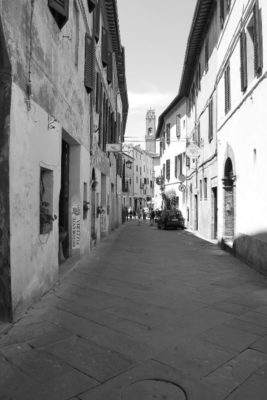
Walking through the alleys of Montalcino
We explore the ramparts of the fortress that dominates the village and enjoy a mid-day snack at the Osteria Enoteca Osticcio.
Here, we indulge in a platter of cold cuts and cheeses paired with a vintage 2011 Brunello from the cellars of Villa Le Prata and Castiglion del Bosco.
It’s worth mentioning that Brunello di Montalcino is one of the most renowned wines in the world, known for its ruby red color and aromas of geranium, cherry, and spices.
Produced from the Sangiovese wine, the Consorzio del Vino Brunello di Montalcino was founded in 1967 to protect and promote the product both in Italy and abroad.
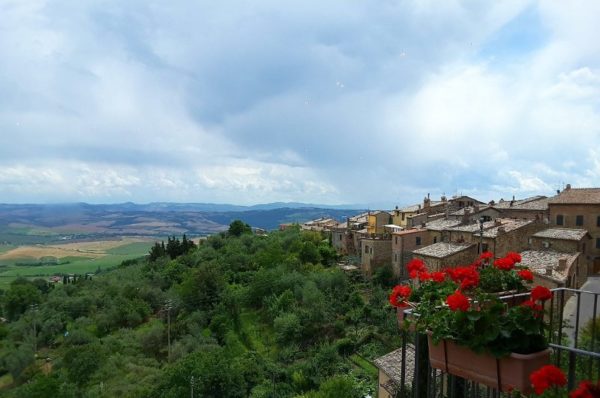
Panorama of the Val d’Orcia from Montalcino
In Montalcino, there are several options to visit local vineyards and taste the region’s renowned wines.
One such opportunity is a tour of the Tricerchi Castle, which includes a one and a half hour guided tour in Italian.
The castle, built in the 13th century by the Altesi family, is located just 10 kilometers from the village on the Via Francigena.
It was completed in 1441 by the Tricerchi family and served as a stop for pilgrims on their way to Rome.
The vineyards, located at an altitude of 290 meters and facing the north, offer a unique microclimate for growing grapes.
In addition to wine tastings, the tour includes visits to the vineyards, the wine cellar and an educational experience on the production process.
Photo Tour #2
After the visit, we continue our journey through the Val d’Orcia to complete the photographic tour we started the day before.
As we drive, we notice that the sun has come out once again, illuminating the lush fields where small herds of white-mantled cattle can be seen grazing peacefully.
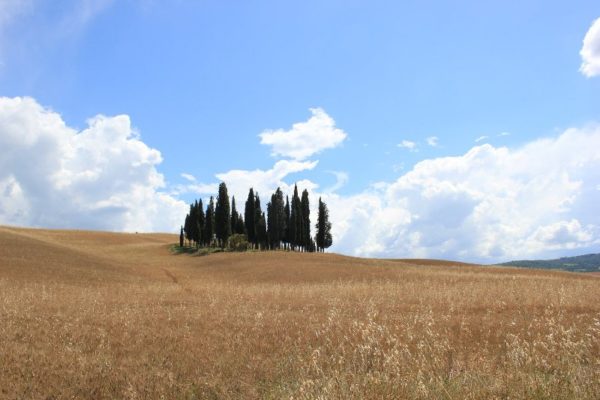
Teatrino delle Volpi
As we were descending from Montalcino towards San Quirico d’Orcia, we had noticed an isolated pine tree that stood out like a mushroom from a wheat field.
This tree had become our target for the day, and we searched the area until we found the country path that led us closer to our goal.
Our mission was accomplished.
A few kilometers down the road, on the Via Cassia, we stopped for a few minutes on the side of the road to take a closer look at the Teatrino delle Volpi.
This famous group of cypress trees is positioned on top of a hill, surrounded by pointed ears of ripe wheat.
Abbey of Sant’Antimo
We arrive at the Abbey of Sant’Antimo, the last destination of the day, under a heavy downpour as a storm rapidly approaches with dark clouds and loads of water.
We park the car at the end of the driveway and protected by umbrellas we walk towards the building surrounded by beautiful olive trees.
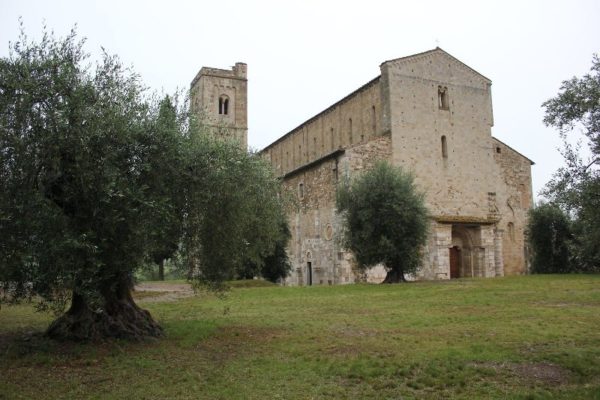
Abbey of Sant’Antimo
The abbey, located about ten kilometers from Montalcino, is said to have been founded by Charlemagne returning from Rome in 781.
The current version of the church was built by Benedictine monks between the eleventh and twelfth centuries.
It had a moment of great prosperity for a few decades, but in the thirteenth century, due to conflicts with Siena, it fell into decline.
Upon entering the church, we find ourselves alone.
The interior is divided into three naves according to the French model of the period.
After a short stop, we return to our car and head home as darkness surrounds us.
This itinerary is a rough guide on what to see in Val d’Orcia in two days, but it can be easily modified to fit your interests and preferences.
Photo Credits: the map photo was downloaded from Visittuscany.com



0 Comments